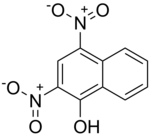Martius yellow
 | |
| Names | |
|---|---|
| Preferred IUPAC name 2,4-Dinitronaphthalen-1-ol | |
| Other names 2,4-Dinitronaphthol; Martinsgelb; C.I. 10315; Acid yellow 24 | |
| Identifiers | |
CAS Number |
|
3D model (JSmol) |
|
| ChEBI |
|
| ChemSpider |
|
| ECHA InfoCard | 100.009.176 |
| EC Number |
|
| MeSH | C057508 |
PubChem CID |
|
| UNII |
|
CompTox Dashboard (EPA) |
|
InChI
| |
| |
| Properties | |
Chemical formula | C10H6N2O5 |
| Molar mass | 234.167 g·mol−1 |
| Appearance | brownish-yellow powder |
Except where otherwise noted, data are given for materials in their standard state (at 25 °C [77 °F], 100 kPa).  N verify (what is N verify (what is  Y Y N ?) N ?) Infobox references | |
Chemical compound
Martius yellow is an organic compound that once was used to protect wool from moths. It is prepared by nitration of naphthol.[1]
Martius yellow stains have been used to stain erythrocytes yellow so that they contrast well with red fibrin in trichrome staining methods such as Lendrum's Picro Mallory and Slidder's Martius, Scarlet and Blue (MSB). It can be combined with other small molecular weight yellow dyes to increase stain intensity.
References
- ^ Raue, Roderich; Corbett, John F. (2000). "Nitro and Nitroso Dyes". Ullmann's Encyclopedia of Industrial Chemistry. Weinheim: Wiley-VCH. doi:10.1002/14356007.a17_383. ISBN 3527306730.
- v
- t
- e









